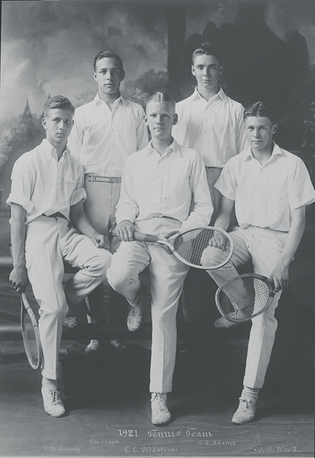
Manuscripts and archives
By 1921, when this photo of the Yale tennis team was taken, tennis was a well-established part of campus life.
View full image
In the 1870s, Americans began to adopt the English garden-party game of lawn tennis, with ladies in whalebone corsets and starched petticoats and men in long white flannels. Perhaps unsurprisingly, one of the people who brought the sport to Yale was the enthusiastic athlete Walter Camp, Class of 1880.
After playing, coaching, and inventing the rules of American football, Camp turned his attention to lawn tennis. In 1883, he organized the first intercollegiate lawn tennis tournament; it took place in Hartford, with singles and doubles matches against Harvard. The Crimson won that year and again in 1884. By 1885, tennis was a craze: the clothier Wallace B. Fenn on Chapel Street advertised tennis and bicycle shoes, from $2.50 to $5.
The new passion for tennis was part of a larger societal change. In the late nineteenth century, golf, bicycling, and lawn tennis became popular town and gown pastimes in private clubs and public parks. Yale historian George W. Pierson ’26, ’33PhD, suggested that the growing popularity of individual competition was a major historical change in “the Yale man.” In the decades after the Civil War, students gradually became more mature and independent. Upper classes became less interested in hazing the freshmen, or fighting in mad rushes, class against class. They turned instead to organized sport.
It wasn’t just students. Alumni living in the New Haven area, especially Yale faculty, continued to play tennis with area residents. By some accounts, tennis came to New Haven through the city’s growing business and Yale’s connections with New York (where tennis was first played in the United States). A group of New Haveners started a tennis club in 1884, and in 1891 the New Haven Lawn Club was incorporated. The club bought a large tract of land off Whitney Avenue, near the current Peabody Museum and School of Management, and is still in operation today.
William Lyon Phelps, Class of 1887, ’91PhD, a prominent Yale professor and celebrity literary critic, played tennis as a student and Yale professor at the lawn club. He and his fellow players were serious about their tennis: he wrote in his memoirs that “it was the only club in America, as far as I know, where tennis was played in the open air with deep snow on the ground.” Phelps used his tennis skills to meet and get to know people he wrote about in his columns and memoirs.
Yale’s first tennis courts were at Hillhouse and Sachem streets, at the base of Science Hill. By the 1910s, there were courts at the Yale fields on Derby Avenue near the Yale Bowl, and in 1924, students asked for more courts so they wouldn’t have to wait so long for an available one. By the mid-twentieth century, the addition of new courts made it possible to welcome New Haven schoolchildren to play there, although there were also courts in New Haven city parks and schoolyards by then. Today, the Cullman-Heyman Tennis Center, built thanks to the generous leadership gifts of the late Samuel J. Heyman ’60 and the estate of the late Joseph Cullman III ’35, is one of the finest intercollegiate tennis facilities in the nation.
We’ll leave the final word to Cole Porter, Class of 1913, who captured the popularity of tennis in the title song from his classic 1934 musical:
When mothers pack and leave poor father
Because they decide they’d rather be tennis pros,
Anything goes.
 loading
loading